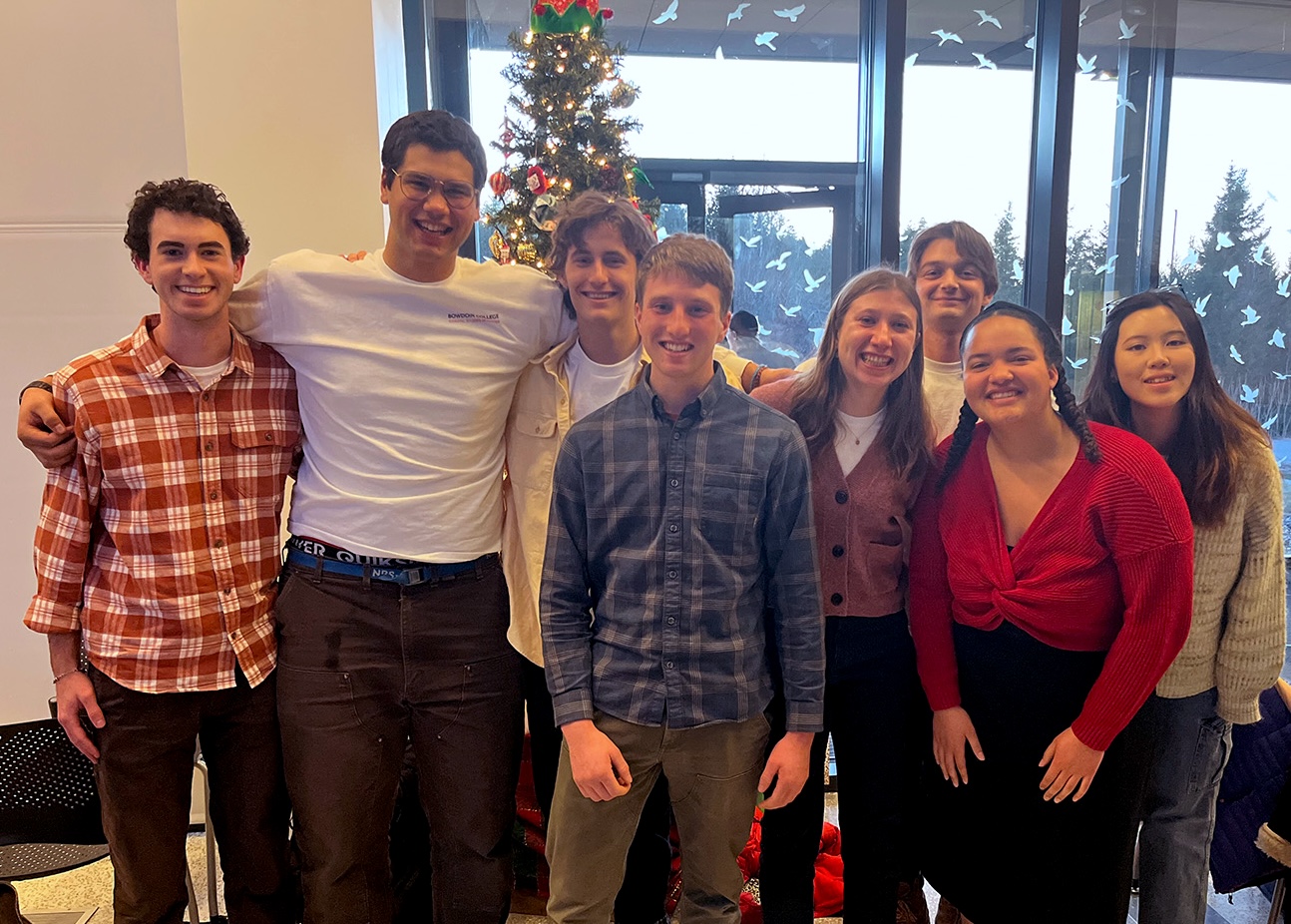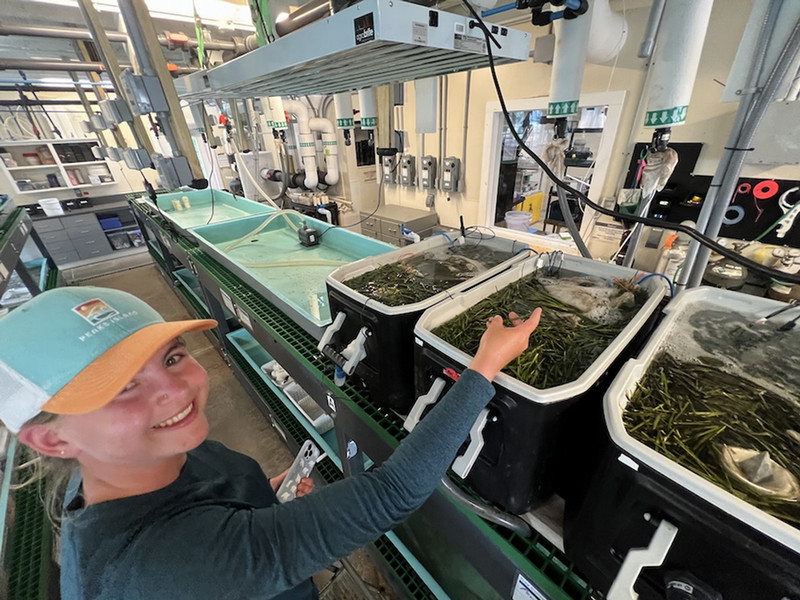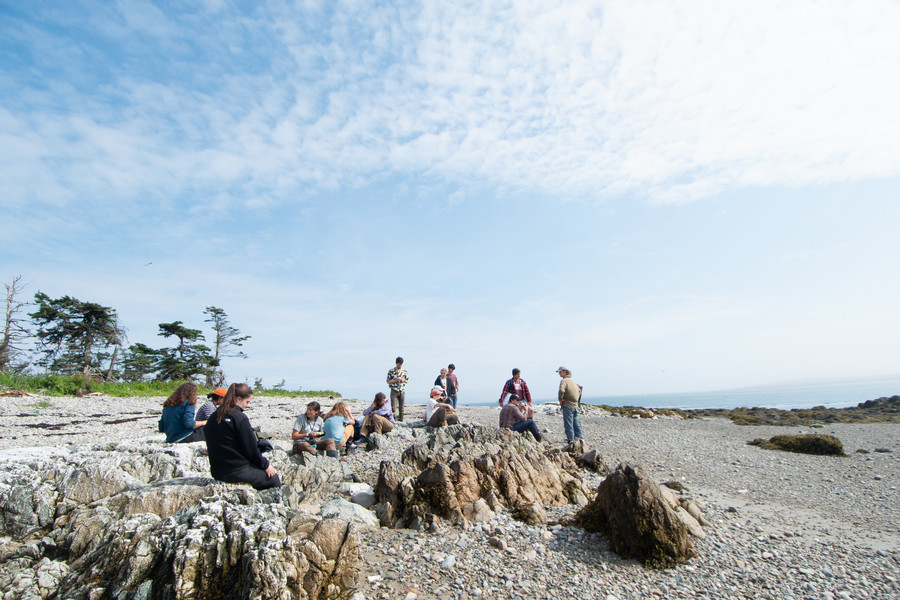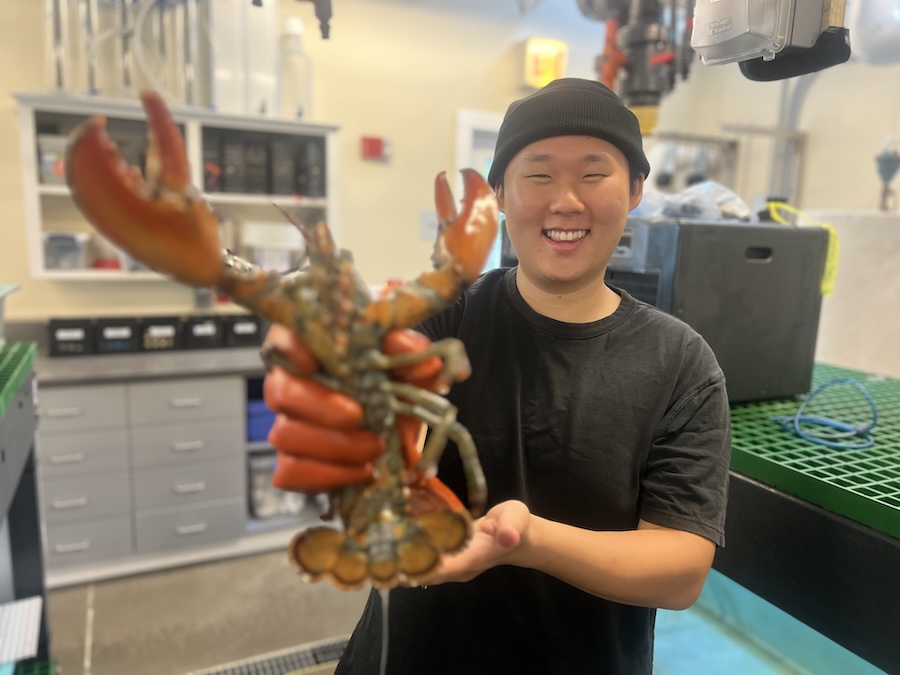Schiller Semester Ends with a Tidal Wave of Student Research
By Rebecca GoldfineThe Bowdoin Coastal Studies Semester concluded its immersive academic program with a daylong research symposium on December 15 at the Schiller Coastal Studies Center.
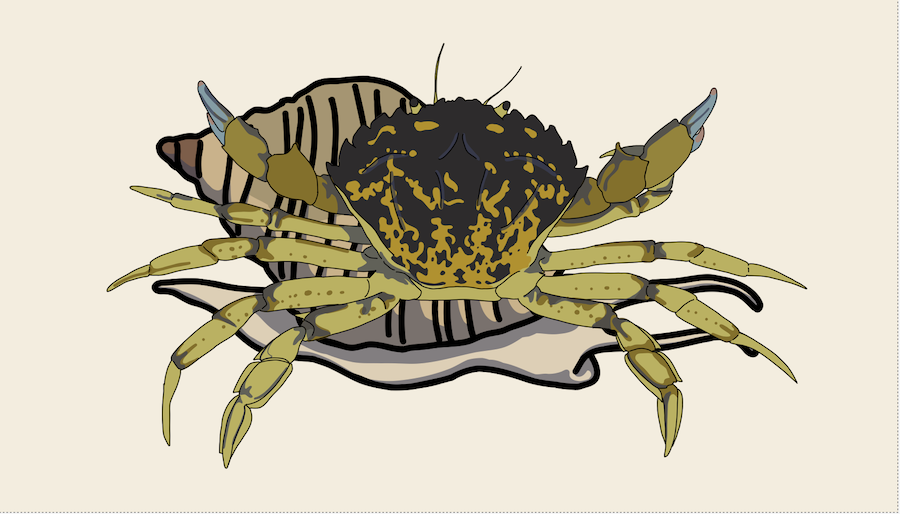




Twelve Bowdoin students—joined by students from Colby-Bigelow's Sea Change Semester—presented an array of new findings about the transformations taking place in our sea and on our shores.
Each student in the Bowdoin Coastal Studies Program conducts a semester-long independent research project, a capstone experience that is celebrated with oral presentations at a December conference. In recent years, Bigelow and Bowdoin have been symposium partners, bringing students together from a number of colleges and universities.
Holly Parker, director of the Schiller Coastal Studies Center, said students from both programs enjoy the chance to meet one another and hear what their peers have been working on. “Students talk about their science on the breaks,” she observed.
This year, some of the students’ friends and family members joined the symposium audience, which swelled to about forty. Another seventeen or so watched the Friday event remotely with Bowdoin's livestream technology. Additionally, Parker invited all the community members who had engaged with Coastal Studies students during the course of the program.
“We made a big push this semester to connect students with members of the community, like oyster farmers, marine patrollers, clam diggers—people who are living the science,” Parker said. Other invited guests included a kelp farmer, seaweed harvester, and state representative who serves coastal communities. “We wanted students to have a context for the research they were doing, how these topics might actually impact people.”






Finn Torres ’25, one of this semester's Coastal Studies students, said meeting with Maine fishermen and aquaculturists to learn about their lives and concerns was the most valuable part of the program for him. "Maine’s fishing industry is a crucial part of its economy and it's important for anyone working with marine life in Maine to understand and see that," he said.
Curt Brown, a marine biologist with the lobster processing and distribution company Ready Seafood, was one of two people the students met when they visited Portland's working waterfront in September. (The other was Bill Needelman, the city's waterfront coordinator.)
Part of Brown's job at Ready Seafood is to collaborate with colleges and universities, he said, and he was happy to give Bowdoin students a tour of the facility. "Any opportunity to share what we do as a company with a group of intelligent and eager students is a no brainer," he noted. "College students in Maine are a big part of the future of Maine's marine economy."
Brown added that the visit from Bowdoin students was a highlight for him, and that "a lot of really great connections were made." Curious by the students' research topics, he was eager to attend Friday's symposium. But "to say last Friday exceeded my expectations would be an understatement," he said. "The time, effort, passion and enthusiasm that the students put into their work blew me away."
Many of the students developed their research projects after meeting with community members like Brown, Parker said. “The students all came up with such creative ideas,” she marveled.
Research Subjects: Snails, Mummichogs, Oysters, Crabs, Scallops
The Bowdoin student projects covered a range of topics, including how snails' sense of smell may be impacted by invasive predators, and whether mummichogs—a small species of shoal fish—can learn to navigate a maze and retain this information after one week.
Focusing on two habitats—a marsh and a cove—Luisa Wolcott-Breen ’25 researched the population size, sex distribution, and coloration of the green crab, a destructive invasive species in Maine. (Green crabs, despite their name, are not always green. If they wait long between moltings, their shells turn orange and red.)
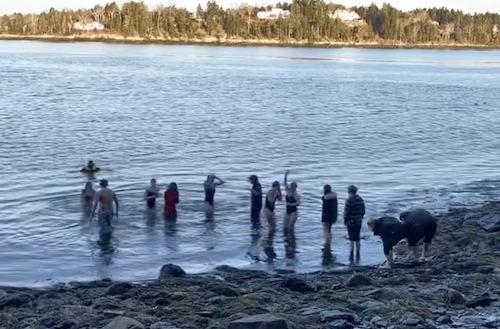 No matter that in just one hour they had a daylong symposium to attend, where each was scheduled to give a talk. The twelve Coastal Studies Semester students were determined to keep up the daily rite they had maintained since early September—the "polar plunge," an increasingly frigid dip into the ocean. (Well, to give her credit, just one student, Luisa Wolcott-Breen ’25, made it in every single day.)
No matter that in just one hour they had a daylong symposium to attend, where each was scheduled to give a talk. The twelve Coastal Studies Semester students were determined to keep up the daily rite they had maintained since early September—the "polar plunge," an increasingly frigid dip into the ocean. (Well, to give her credit, just one student, Luisa Wolcott-Breen ’25, made it in every single day.)
At 8:15 a.m., the group headed to the rocky beach near the Schiller Coastal Studies Center’s lab, the cries of their instructor trailing them. “Wait!” called out Jaret Reblin, associate director for science at the Schiller Coastal Studies Center. “Don’t you have a symposium to get to?”
The students laughed off his worries, shed their clothes down to their swimsuits, and with a simultaneous cry of “Good Morning, Schiller!,” they waded in, a few of them diving and dunking and yelling with joy.
"It is important to understand these things about an invasive species so you know how many you are dealing with, where they are most prominent, and what the difference in color could tell us about the crabs’ life stages," she explained.
(See the complete list of student projects below.)
In response to the ongoing debate about what to use for lobster bait, Danny Lee ’25 investigated the physiological effects on lobster if they are fed only a diet of pork rind. Lee said he got his idea after his Coastal Studies cohort visited midcoast's Hurricane Island Center for Science and Leadership. “I didn’t know the lobster industry used pork, so I wanted to do a comparative study with the standard bait type of fish,” he said.
Traditionally, lobstermen have used herring to bait their traps, but the herring population has dwindled drastically due to climate change and overfishing. To maintain its multi-million dollar lobster business, the state of Maine and the lobster industry have been trying to come up with a viable bait alternative. Pork rind is one option being explored because, as a waste product from meat processing, it is very cheap.
But Lee had questions about this choice. After setting up an experiment in which he fed one group of lobsters in the lab a fish diet and the other a pork diet, he tested their metabolic rates, reaction times, and energy levels. Overall, lobsters on the pork diet demonstrated worse outcomes than their counterparts who ate the fish. One even died.
“Pork has a higher fat percentage…in comparison to fish, which has a higher protein composition,” he explained, so it takes energy to break down into a viable energy source. “Pork is not natural. It is hard on lobster digestive capabilities. Some lobsters would rather starve than eat the pork.”
Lee is one of several students who want to continue their research next summer or year as an independent project. He said doing independent research was an experience he had hoped to have at Bowdoin. “It gave me a picture of what I want to do in the future with research and marine science in general," he said. Plus, "it was nice being around people who were interested in doing the same thing as me (i.e., research, marine science, etc.)."
Reflecting back on the past three and a half months, Wolcott-Breen said one of the "most magical things about the semester was being around people with different personal and educational backgrounds, though we all shared a passion for the ocean." She also appreciated having so many "opportunities to learn outside the classroom."
"It was such an honor to get to share so many moments of curiosity and passion with the Coastal Studies Semester cohort," she continued. "From talking with Maine fishermen who know the water better than anyone to visiting an art gallery about the working waterfront in Brunswick, we had a lot of unique learning moments this fall."
Bowdoin students supervised by Katie DuBois, Olaf Ellers, and Jaret Reblin:
- Roger Wilder ’25: Pavlov's fish? Mummichog spatial cognition through maze learning
- Emma Fasullo ’25: A Matter of Quartz? Examining Substrate Composition and the Settlement of Benthic Communities
- Finn Torres ’25: A Snail of Two Cities: How invasive crustaceans in Maine have changed our snails’ sense of smell
- Camille Beaulieu ’25: Aqua-scuse Me? Assessing viability of multi-trophic aquaculture systems using Eastern Oysters and Knotted Wrack
- Emma Olney ’25: Burrowed Breath: Invasive Carcinus maenas abundance and salt marsh sediment oxygen
- Abigail Steinwachs ’25: The Effect of Oyster Farms on Phytoplankton Abundance in the New Meadows River
- Caroline Vauclain ’25: Carbon and Nitrogen in Sediment Surrounding Oyster Farms
- Luisa Wolcott-Breen ’25: Carcinus Menace: investigating population size and coloration in an invasive species
- Jolie Ganzell ’25: [OH-] Crab! The effects of ocean acidification on Carcinus maenas metabolism
- Eva Ahn ’26: Scallops These Days! Valve Opening Response of Placopecten magellanicus to Particle Video Stimuli
- Danny Lee ’25: Surf n’ Turf: The Physiological Effects of Pork vs. Fish Diet on Homarus americanus
- James Benavides ’25: Going for a Light Swim: The Impact of Artificial Light Intensities on Placopecten magellanicus Swimming Behavior
Bigelow students:
- Juvelisse Medrano, Manoj Rayaroth, Christoph Aeppli: Exploring proposed pathways of photochemical degradation of polycyclic aromatic hydrocarbons (PAHs) in the ocean.
- Lucas R. Girard, José A. Fernández Robledo: Emerging Techniques for Studying Contagious Clam Cancer: Experimental Culture Mediums and Transfections
- Lauren Valenzuela, Julia Brown: Investigating the Effects of an Oxygen Minimum Zone on the Virus to Prokaryotic Ratio and Bacterial Communities
- Annabelle Warren, Jonathan Curtis, Rachel Sipler: Macroalgae and Microplastics: Comparing Microplastic Accumulation on Rockweed and Kelp in the Gulf of Maine
- Nikita Colling, Laura Lubelczyk, Nicole Poulton: “Phagotrophic Response to a Change in Light Availability for Mixotrophic Dinoflagellate Heterocapsa triquetra”
- Melyssa Correa-Diaz, Manoj Kamalanathan: Influence of Osmotrophy versus Photosynthesis on Phytoplankton Productivity
- Elias Porter, Shane Farrell, Douglas Rasher: Get Off My Turf: Chemical Warfare & Feedback Loops in the Gulf of Maine
